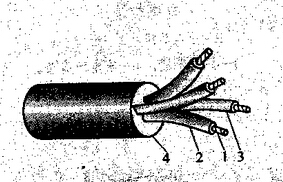Mine cable is divided into three kinds of armored cable, rubber cable and plastic cable.
1, armored cable
The so-called armored cable, is the use of steel wire or steel tape to install the cable. Its greatest advantage is its high dielectric strength and strong resistance to pull. Therefore, steel wire armored cable is suitable for use as a vertical shaft or a steeply inclined roadway. Steel tape armored cable is suitable for horizontal or gently inclined roadways. Introduction.
2, rubber cable
The rubber cable is divided into three types: ordinary rubber cable, fire-retardant rubber cable, and shield rubber cable. For the power supply of downhole mobile devices, flexible, flexible rubber cable is used.
(1) Ordinary rubber cable
Ordinary rubber cable structure diagram
The picture shows the structure of a common four-conductor rubber cable, wherein 1 is a conductive core wire made of a plurality of thin copper wires; 2 is a rubber insulation layer outside the wire core wire, also called an inner sheath; 3 is an oak The cushion core is placed between the cores and functions as a fixed core and shockproof. It is also used to make the cable appearance circular after cable is laid; 4 is the outermost rubber sheath of the cable, also called outer sheath. It is used to increase the mechanical strength of the cable and protect the insulation of the conductive core wire inside the cable.
There are four conductive core wires in the inner conductor of a typical rubber sheath cable, of which three are the main core wires (thick) and the other one is thinner, which is the grounding wire. In addition to the above-mentioned four-core rubber cable, there are two-core, three-core, six-core, seven-core rubber cable. In a four-core or more rubber cable, except for the three main core wires and one ground wire, the rest are all control wires for control circuits. The outer sheath of ordinary rubber sheathed cable is made of natural rubber. Because natural rubber can be burned, and the gas that is decomposed during combustion can help to ignite the fire, it is easy to cause fire. Therefore, it is not advisable to use common rubber sheathed cables in coal mines where there are dangers of gas and coal dust explosion.
(2) flame retardant rubber cable. The construction of this cable is the same as that of a normal rubber-jacketed cable, except that its outer sheath is made of neoprene rubber. Neoprene can also be burned, but when it burns, it decomposes to produce hydrogen chloride gas, enveloping the flame, isolating it from the air, and thus extinguishing it very quickly, without burning along the cable. Therefore, this flame-retardant rubber sheath cable should be used underground.
(3) Shielded cables.
1-Electrically conductive rubber core; 2 - outer sheath; 3- - main core wire;
4, the main core insulation; 5 - the main core shield; 6 - grounding line
Mine shielded cable general structure diagram
The shielded cable is mainly used in the working area of ​​the mining area to improve the safety of the work. The shielding materials are two kinds of semiconductor materials and nylon mesh materials. In addition to the general structure of the shielded cable mentioned above, there are shielded cables that supply power to the kV class semi-fixed equipment, the MCPTJ type cable that supplies power to the kV class (unit), and the 6kV MYPJT type double layer that supplies power to the mobile equipment. High-voltage cables and so on.
One of the advantages of shielding is to avoid serious accidents caused by the short-circuit between phases when the main conductor of the cable is damaged. Another advantage is to avoid the danger of electric shock due to cable damage. Due to the fact that the shielded cable cooperates with the leakage detection relay, it has the function of cutting off the fault line power in advance, effectively preventing the occurrence of leakage spark and short circuit arc. Therefore, it is particularly suitable for places with gas or coal dust explosion hazards and frequent electrical outages, ie the power supply system of the mining face.
3, plastic cable
The main structure of this type of cable is basically the same as the two cables mentioned above. Only its core insulation and outer sheath are made of plastic (polyvinyl chloride or cross-linked polyethylene).
Its advantages are: allow for high working temperature, good insulation performance, corrosion resistance of the sheath, and unrestricted drop in laying. If the outside of the cable is armored, the conditions for use are the same as those of the armored cable; if the outside is not sheathed, the conditions for use are the same as for the rubber cable. Therefore, when conditions permit, plastic cables should be used as much as possible.
The product is hydrophobic and oil-thinning, which can make pollutant particles, such as grease, oil, lime and less environmental pollutants attached to the matrix, and also make it easy for people to remove these dirt from the coating surface without applying friction agent ("easy cleaning" effect). Product features: 1. Strong hydrophobicity 2. Strong viscous resistance 3. Easy removal of dirt on glass, lime. Other properties: 1. Transparent liquid 2. Wear resistance 3. No temperature change 4. Simple operation 5. Chemical resistance
Scope of use and more glass surface treatment:
Window Glass + Building Glass
Automobile Glass
The glass surface of the bathroom
Nano Coating For Construction Glass
Anti Fingerprint Coating For Glass,Glass Coatings,Anti Fingerprint Coating For Glasses,High Performance Coatings
Guangdong Giant Fluorine Energy Saving Technology Co.,Ltd , https://www.tuwtech.com

